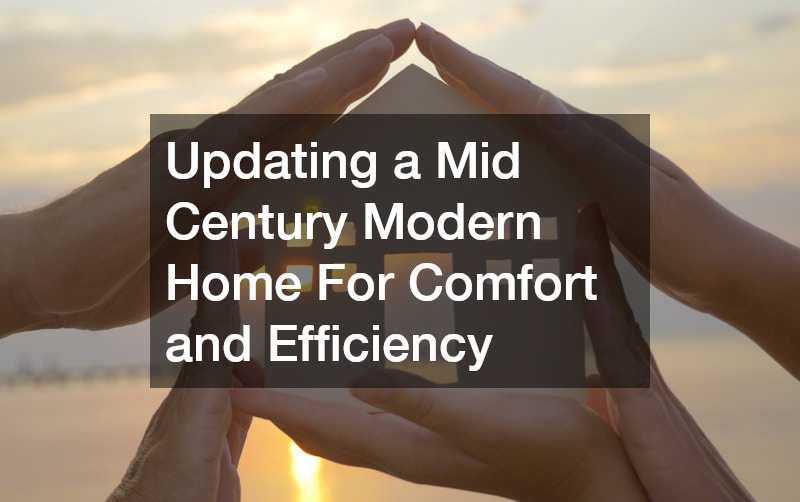Mid-century modern homes remain highly desirable for their distinctive character, clean lines, and thoughtful integration with surrounding landscapes. While these properties have timeless appeal, many were built before modern comfort standards, contemporary building practices, and today’s emphasis on efficiency. Updating them requires a careful balance of preservation and improvement, keeping what makes the style iconic while elevating performance, safety, and comfort. Homeowners who approach the renovation with intention can create a refined, modern living environment that stays true to the spirit of the original design while functioning far better in today’s world. Enhancing insulation, improving HVAC performance, upgrading windows, rethinking interiors, and addressing essential maintenance tasks such as basement waterproofing or oil tank removal all contribute to a safer and more comfortable home. With the right strategy, a mid-century modern home can feel beautifully renewed without losing its architectural soul.
What Are Key Features to Retain in a Mid Century Modern Home?

A thoughtful remodel always begins with understanding what should stay. Mid-century modern homes are beloved because of their defining design characteristics, and honoring these features protects not only the home’s aesthetic value but also its historical relevance.
Iconic Architectural Elements
Mid-century architecture is instantly recognizable because of its minimalist geometry, flat or low-pitched rooflines, and expansive use of glass. These forms create a clean, understated appearance that still feels fresh today. Whenever possible, these elements should be preserved. When roofing issues arise, working with a knowledgeable roofing contractor can help maintain the original roof profile while making necessary structural or material upgrades. Retaining these iconic rooflines safeguards the home’s silhouette and respects the architectural style that made the mid-century movement so influential.
Unique Material Choices
This design era embraced a blend of natural and manufactured materials, often pairing wood, stone, and brick with steel or glass. Homes frequently feature tongue-and-groove ceilings, stacked stone fireplaces, and distinctive interior paneling. Preserving these materials or restoring them ensures that the home maintains its authentic texture and warmth. When replacements are necessary, selecting materials that echo the appearance of the originals helps maintain a coherent visual flow throughout the home.
Open Floor Plans
Mid-century modern homes were among the first to adopt open layouts as an intentional design element rather than a structural limitation. These uncluttered spaces encourage movement and connection between living areas, making them highly functional for contemporary lifestyles. Renovations should avoid subdividing rooms or adding unnecessary partitions that detract from the airy feel. Instead, updates should emphasize spacious sightlines, natural lighting, and ease of movement.
Indoor-Outdoor Connections
Perhaps the most iconic element of mid-century design is the strong connection between indoor and outdoor spaces. Large windows, sliding glass doors, and generous patios create a seamless transition between the home and its surrounding environment. Enhancing this connection remains one of the most effective ways to update a mid-century home without compromising its DNA. Adding new plantings, working with fence companies to define outdoor spaces, or creating modern patio areas can further strengthen the harmony between the built and natural environments.
Preserving Historical Integrity
Preservation does not mean freezing the home in time. It means updating thoughtfully, making changes that align with the original design intent. For example, when replacing windows, homeowners can select modern, energy-efficient frames that mimic the narrow sightlines of the originals. When addressing necessary structural work, such as vacuum excavation for underground utilities or oil tank removal, completing the work without altering the visual fabric of the home is essential. Respecting the home’s heritage ensures it remains both functional and architecturally genuine.
How Can Energy Efficiency Be Improved?
Many mid-century homes were built with limited insulation, older mechanical systems, and original windows that do little to improve energy performance. Updating these systems dramatically increases comfort while reducing long-term costs.
Upgrading Insulation
Improving insulation is one of the most effective ways to boost comfort in an older home. Attics, crawl spaces, and exterior walls often lack adequate insulation, making indoor temperatures harder to regulate. Adding modern insulation materials helps retain heat in the winter and keep interiors cooler in the summer. Proper insulation also supports HVAC performance, reducing strain on the heating and cooling system.
Installing Energy-Efficient Windows
Original single-pane windows, although beautiful, are not energy efficient. Replacing them with modern dual- or triple-pane windows that maintain slim frames and clear sightlines preserves the home’s aesthetic while enhancing comfort. New windows reduce drafts, improve sound insulation, and lessen the workload for the HVAC company maintaining the home’s climate system.
Implementing Smart Home Technology
Smart thermostats, automated lighting, and intelligent shading systems improve energy management while enhancing convenience. These features integrate seamlessly into mid-century interiors when chosen for their simplicity and clean design. A carefully placed smart thermostat can help regulate heating and cooling far more precisely, keeping the home comfortable while minimizing wasted energy.
Utilizing Renewable Energy Sources
Solar panels, when installed thoughtfully, can reduce reliance on traditional energy sources. Positioning panels in areas where they do not interfere with the home’s roofline or architectural silhouette ensures that renewable energy updates contribute to efficiency without altering the design. Renewable energy additions pair well with support services such as propane service or local propane suppliers when a hybrid energy strategy makes sense for the location.
Efficient HVAC Systems
Older mechanical systems are often inefficient or nearing the end of their lifespan. Upgrading to a modern, energy-efficient system dramatically improves indoor comfort. Working with a qualified HVAC company ensures the system is properly sized and installed, which is critical for maintaining ideal temperatures without unnecessary energy expenditure.
What Are the Best Practices for Modernizing the Interior?

Interior updates should reflect modern needs while honoring the simplicity and functionality that define mid-century style.
Choosing Contemporary Furniture
Furniture should complement the architecture rather than compete with it. Clean lines, warm wood tones, and simple silhouettes blend seamlessly with original elements. Contemporary pieces with modern upholstery and updated ergonomics enhance comfort while remaining true to the home’s minimalist interior palette.
Integrating Modern Lighting Solutions
Mid-century homes naturally rely on ample daylight, but updated lighting enhances ambiance and utility. Recessed fixtures, globe pendants, and streamlined lamps fit the era’s aesthetic while improving visibility. LED lighting improves energy efficiency, and strategically placed fixtures can highlight architectural features such as exposed beams or original stonework.
Open Concept Space Utilization
Maintaining open layouts ensures the home continues to feel spacious and breathable. Interior updates may include removing visual clutter, selecting low-profile furniture, and arranging spaces to facilitate conversation and movement. Avoiding unnecessary barriers maintains the design’s emphasis on openness.
Incorporating Modern Art and Decor
Mid-century modern spaces pair beautifully with contemporary art, textured rugs, and minimalist decor. Introducing artwork with organic shapes or abstract themes enhances visual interest without overwhelming the space. Decor should remain purposeful, emphasizing quality over quantity.
Maintaining Original Design Aesthetics
When renovating, it is important to avoid trends that clash with the era’s aesthetic. Simple lines, thoughtful color palettes, and timeless materials maintain the integrity of the original design. Even practical additions such as local dumpster rentals for cleanup should support a renovation process that prevents damage to original surfaces and architectural elements.
Which Sustainable Materials Are Ideal for Renovation?
Sustainability is an important consideration in modern remodeling, and mid-century modern homes lend themselves well to eco-friendly upgrades.
Reclaimed Wood
Reclaimed wood adds warmth and character to interior spaces while supporting sustainable building practices. It complements original wood paneling and can be incorporated into flooring, shelving, or accent walls.
Bamboo Flooring
Bamboo is durable, attractive, and renewable. It works well in mid-century interiors due to its clean appearance and natural tone. Bamboo flooring provides a modern take on traditional wood floors while offering long-term durability.
Recycled Glass Countertops
Recycled glass countertops blend sustainability with a sleek, modern aesthetic. Their reflective surfaces complement mid-century interiors and provide a durable, low-maintenance option for kitchens and bathrooms.
Low-VOC Paints and Finishes
Low-VOC paints improve indoor air quality and reduce exposure to harmful chemicals. They come in a wide range of colors that echo the earthy, neutral tones popular in mid-century design.
Eco-Friendly Insulation Options
Modern insulation materials, such as recycled denim or cellulose, offer sustainable alternatives that perform well in older homes. These options help regulate temperature without introducing harmful chemicals.
How to Enhance Indoor Air Quality?
Air quality significantly influences comfort, health, and overall home performance.
Using Air Purifiers
Air purifiers help remove pollutants, allergens, and particulates. They are especially beneficial in older homes where dust or residual building materials may affect air quality.
Incorporating Green Plants
Indoor plants enhance air quality naturally by absorbing carbon dioxide and releasing oxygen. Their organic shapes and textures also complement mid-century design aesthetics.
Ventilation Improvements
Many older homes lack adequate ventilation. Updating kitchen and bathroom exhaust fans, adding whole-house ventilation systems, or improving ductwork ensures cleaner indoor air and reduces humidity-related problems.
Avoiding Toxic Materials
During renovations, selecting materials without harsh chemicals or toxic finishes is essential. Avoiding products that off-gas helps create a safer, healthier home environment.
Regular HVAC Maintenance
Routine HVAC maintenance improves air circulation, filters pollutants, and keeps systems running efficiently. Maintenance also helps identify issues early before they affect indoor comfort.
What Are the Steps for a Landscape Update?

Updating outdoor areas enhances the mid-century emphasis on blending architecture with nature.
Sustainable Landscaping Practices
Eco-friendly landscaping improves curb appeal and supports long-term environmental health. Using mulch, drought-tolerant plants, and thoughtful grading helps preserve water and reduce erosion.
Native Plant Selection
Native plants thrive with minimal maintenance, complementing the natural landscape. Their organic forms pair well with mid-century architecture.
Water-Conserving Irrigation Systems
Smart irrigation systems reduce water waste and help gardens flourish. Drip systems and moisture sensors keep landscapes healthy while conserving resources.
Creating Outdoor Living Spaces
Patios, seating areas, and pathways extend the home’s living space outdoors. These features support the mid-century ideal of indoor-outdoor harmony.
Hardscape Enhancements
Hardscaping, such as stone walkways or concrete terraces, adds structure and durability. When necessary, working with professionals for vacuum excavation ensures underground utilities remain undisturbed during installation.
How Can Modern Technology Integrate Seamlessly?
Modern technology can enhance convenience without detracting from mid-century charm.
Smart Lighting Systems
Smart lighting adds convenience and saves energy. These systems can maintain minimalist aesthetics while offering personalized control.
Automated Climate Control
Automated climate control systems improve efficiency and maintain consistent indoor comfort. They work seamlessly with updated HVAC systems.
Advanced Security Solutions
Security cameras, smart locks, and discreet sensors enhance safety without compromising design.
Voice-Activated Home Assistants
Voice assistants help manage lighting, temperature, and entertainment while remaining unobtrusive.
Smart Appliance Integration
Modern appliances offer improved performance and blend well with retro-inspired finishes that suit mid-century kitchens.
Tips for a Successful Kitchen Remodel
Kitchens are central to daily living, and mid-century kitchen updates require balance and thoughtful planning.
Retaining Classic Cabinetry
Original cabinetry, if in good condition, can be refinished rather than replaced. Preserving these elements maintains the home’s authenticity.
Modern Appliance Upgrades
Upgrading appliances enhances function and efficiency. Sleek, stainless steel designs pair well with mid-century cabinetry.
Efficient Layout Design
Maintaining open sightlines and efficient work zones ensures the kitchen remains both functional and true to its design heritage.
Incorporating Sustainable Materials
Sustainable countertops, flooring, and fixtures support environmental goals and elevate the kitchen’s appearance.
Enhanced Lighting Techniques
Under-cabinet lighting, updated pendants, and energy-efficient fixtures improve visibility while preserving the home’s aesthetic.
What Bathroom Updates Combine Style and Function?
Bathrooms benefit significantly from modern updates that improve efficiency and comfort.
Sleek and Energy-Efficient Fixtures
Low-flow faucets, modern showerheads, and stylish sinks enhance function while maintaining a streamlined look.
Space Optimization Techniques
Floating vanities, well-placed mirrors, and creative layouts maximize smaller bathroom footprints.
Introducing Spa-like Elements
Heated floors, updated tilework, and spacious showers bring a sense of luxury to older bathrooms.
Waterproof and Durable Materials
Durable materials such as porcelain tile and moisture-resistant finishes improve longevity. Addressing moisture issues through basement waterproofing when applicable also prevents future problems.
Smart Storage Solutions
Built-in shelving, recessed niches, and organized cabinetry create practical storage without cluttering the space.
What Are the Budget Considerations for a Remodel?

Careful planning ensures that the renovation stays on track both financially and stylistically.
Prioritizing Remodeling Tasks
Focusing first on essential updates such as insulation, roofing repairs, HVAC upgrades, or necessary structural work ensures the home remains safe and functional. Obtaining a roofing estimate early helps homeowners prepare for one of the most significant costs in older homes.
Cost-Effective Energy Upgrades
Energy improvements offer long-term savings. Enhancing insulation, replacing windows, or improving climate control remains cost-effective over time.
Choosing Affordable Materials
High-quality but affordable materials help stretch the budget while maintaining design integrity.
Planning for Unexpected Costs
Renovations in older homes sometimes reveal hidden issues, such as outdated wiring or buried tanks that require oil tank removal. Budgeting for contingencies ensures the project continues smoothly.
Maximizing Return on Investment
Updates that improve structural integrity, efficiency, and curb appeal offer the best return. Proper planning, cleanup support from local dumpster rentals, and thoughtful design choices all contribute to long-term value.
Final Thoughts
Updating a mid-century modern home for comfort and efficiency requires a careful balance of preservation and modernization. Honoring the home’s architectural roots while implementing energy-efficient upgrades, interior enhancements, and sustainable materials ensures the space feels both timeless and contemporary. Essential improvements such as insulation upgrades, HVAC enhancements, landscape updates, and necessary maintenance work like vacuum excavation or oil tank removal support both safety and comfort. Thoughtful planning, strategic budgeting, and respect for the original design help homeowners create spaces that feel warm, functional, and architecturally authentic. With the right approach, a mid-century modern home can continue to shine for decades, offering both the charm of classic design and the comfort of modern living.
